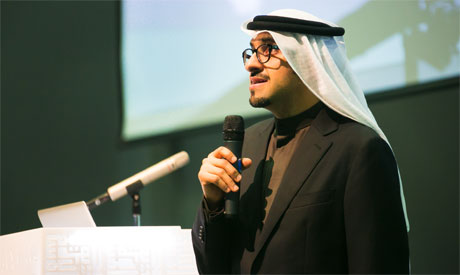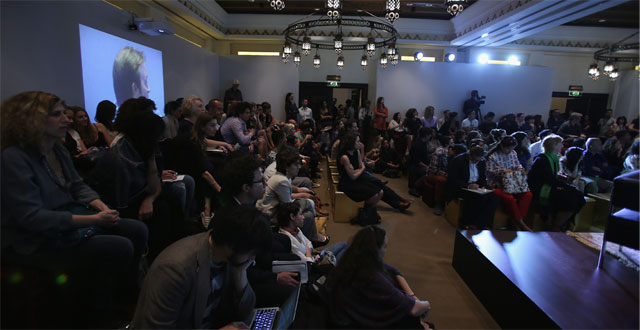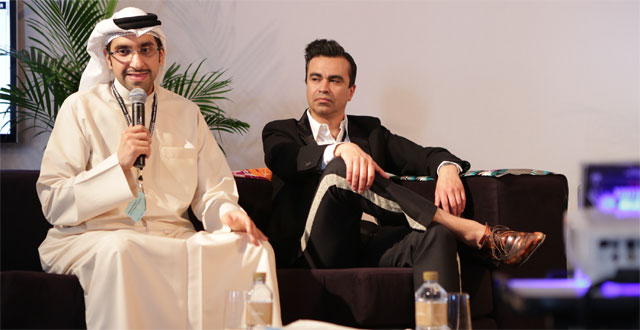Sultan Sooud Al Qassemi, the co-director of the ninth Art Dubai's Global Art Forum titled 'Download Update?' talks to Ahram Online about the initiative that brings debate on the exchange between art and technology to Dubai

Sultan Sooud Al-Qassemi, Global Art Forum Kuwait, 2015 (Photo: courtesy of Art Dubai)
As artists progressively turn to the digital world to find ideas, create work, and sell their art, Art Dubai's educational arm, the Global Art Forum (GAF), zooms in on technology and its relationship to art and culture.
Its title, Download Update?, conceived by director-at-large Shumon Basar, enacts the incessantly forward-driving nature of modern-day technology. But Basar left the question mark in there too - probably to hint that the forum will not be a blind glorification of technology, but rather a critical look at how its rules can, and should be navigated, negotiated, and even at times - broken.
The series of talks, presentations, and discussions kicked off in Kuwait on 14 and 15 March -- the first time Kuwait hosts the forum— and will continue in Dubai from 18 to 20 March.
The GAF’s co-director – with Turi Munthe – Sultan Sooud Al Qassemi, who established the Sharjah's Barjeel Art Foundation, and is a prominent commentator on current affairs in the Middle East, spoke to Ahram Online about the ninth edition of the forum, and his views on the way technology is influencing the Arab art world.
Ahram Online (AO): What is the overarching vision for the year’s art forum?
Sultan Sooud Al Qassemi (SAQ): The idea behind this year’s GAF is to study and debate the role and impact of technology on art and culture, internationally, and in the Gulf. We’ve invited a number of practitioners, a number of scholars, a number of artists who straddle both spheres: technology and culture.
AO: Who’s the target audience for the GAF, in your view?
SAQ: Well I think the GAF compliments the fair, the fair is a commercial fair, so the GAF is its educational arm. We expect to have a mixture of students, of academics, of artists, of collectors, of journalists. So really it is an eclectic mix.
AO: What is something that you’ve seen as successful in past editions of GAF that you want to capitalise on, and something that you maybe wanted to avoid?
SAQ: I like that the GAF is smaller than other conferences, there’s this intimate nature to it, and the room doesn’t get over 200 people. I like the fact that it’s very accessible to the fair. I like the fact that the speakers were both Middle Easterners and international, there was a good gender balance, a good regional representation. So I think all these are all strengths. It also isn’t too aloof as a forum. It welcomes people who haven’t been to these dialogues before, because it doesn’t only talk about art. It’s a forum about the everyday world, with an art angle to it.
This year we’ve added a couple of Arabic language panels…this is maybe one thing that we’ve changed from other editions.
AO: And can you tell me about the title of the forum?
SAQ: It’s an interesting title that we have to thank Shumon (Basar) for. The idea is playing on the role of technology and how you come across this message almost on a weekly basis when you use a computer. Do you want to download the latest software? Do you want to move on? Do you miss out if you don’t? Do you want to be an early adaptor? Do you want to wait for other people to download? So it really tells you a lot about your own identity. So all these are reflections on technology and how it impacts our daily culture.

Art Dubai 2014, Global Art Forum 8 (Photo: courtesy of Art Dubai 2014)
AO: How do you see that the art scene in the Arab world is dealing with the technology boom?
SAQ: I think there is a huge momentum that has been gaining force over the past three, four years. So because a lot of the Arab art market is dominated by younger artists, who don’t have legacy issues to deal with, many of them have grown with this technology, it’s second nature to them. Many of them are millennials, many of them were born in the late 80s, early 90s, and for them technology is an extension of their personality. And you see them adapt this technology into their work, seamlessly. So amongst these artists we have Lawrence Abu Hamdan, who is a participant in the GAF, and Manal Al-Dowayan, who has included a lot of technology, documentation, archiving, video and film into her recording of Saudi history.
AO: How do you think the Internet affected the collector’s market in the Arab world?
SAQ: Oh there’s no doubt that the Internet has greatly contributed in a positive manner to the art market. There’s a lot of art that was inaccessible to people. On our website we have one of the largest resources for art, and artists email me and tell me that “thanks to the fact that my art is available online through your website, buyers have contacted me to buy my work.”
Then you have a lot of instances where artists who face barriers, such as artists who are in Iraq, Syria, or Palestine, use Dropbox to send the image, and then you download it, and they give you a license to print it. So you save on transport costs, logistics and the difficulty in transporting from conflict zones, a photograph, or a video, or a multimedia work, all of this you can transport seamlessly through the Internet, and still respect the intellectual property rights of the artist.
AO: You travel a lot and visit galleries and museums, and you are obviously still attached to the materiality of artwork. Do you see art moving more and more online or is there still going to be this need to interact with art in real life?
SAQ: There’s a few things to be said here. First, there’s a movement in Western museums to put their work online. After a period of reluctance and hesitation, we see more and more museums announcing that they’re putting all their collections online, not only what is on public display. And as you know, most Western museums have between two and five percent of their collections on display.
And the second thing is that nothing will replace the physical enjoyment of standing in front of an artwork, a sculpture, a painting, and enjoying the setting, the size, the dimension, and the venue. But many people are not able to travel to Western Europe, or are not given visas, in parts of Africa and the Middle East. I consider myself to be very fortunate, and that’s why whenever I travel I make it a point to try to visit as many museums as possible. And also, I photograph and I share. And I see a lot of people favourite-ing, a lot of people saving these images and commenting on them. There is a thirst for this knowledge, and I’m very glad to see many Western institutions improving the access to their museum collections.
AO: Do you think that as art moves online, the public can start to curate their own virtual museums, build their own narratives and escape the curated narratives of museums?
SAQ: This point tackles the role of curators. And curators are individuals who are able to tell a story, and create threads between works. Today, you have a lot of curation taking place online. You see a lot of amateurs, or non-professionals curating online. And I think museums would like to encourage this. I don’t think that amateur curators will replace professional curators. But I do believe that this is part of the democratisation process of art- making art accessible to everybody.
AO: The Internet is not an art gallery; there’s so many other rooms online. Do you think that drowns out art or makes it more connected to other social and political realms, and makes it more relevant?
SAQ: I think art is just one component of the Internet. It’s not the only thing there, and people should not only go online to see art. And there are nasty things happening in the world of course. There’s terrorism, famine, crises, all over the word, especially in the Middle East. But that doesn’t mean we neglect the role of art in archiving, in documenting, in photographing, and in recording history.
Art is in my opinion is too small a component on the Internet. We need to see more of it. Because art is a universal language, and as the Internet globalises, you need universal languages to cross these frontiers, whether it’s music or art or culture. So I think art is an essential part of the globalisation of humanity. I think it’s one of the most essential components on the Internet.

Sultan Sooud Al Qassemi (left), Oscar Guardiola-Rivera (right), Global Art Forum 7. 2013 (Photo: courtesy of Art Dubai 2013)
fonte: @edisonmariotti #edisonmariotti http://english.ahram.org.eg/News/125362.aspx
Ahram Online is a media partner of this year's edition of Art Dubai


Nenhum comentário:
Postar um comentário